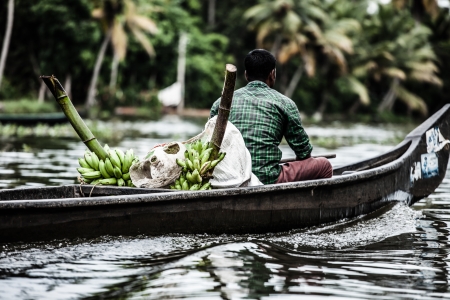Introduction to Desi Fish Cleaning Traditions
In the heartlands of India, fish holds a special place in the daily lives and culinary traditions of countless rural households. From the lush banks of the Ganges in West Bengal to the backwaters of Kerala and the riverine villages of Assam, fish is not just a source of nutrition but also an integral part of local customs, festivals, and rituals. In these communities, cleaning fish is much more than a kitchen chore—it is a family ritual steeped in age-old wisdom and desi ingenuity. Instead of reaching for modern stainless steel knives, many rural Indian families continue to rely on traditional methods passed down through generations. These unique techniques use locally available tools or even bare hands, reflecting both resourcefulness and respect for ancestral practices. The choice to avoid knives stems from practical reasons—knives are not always accessible in remote areas, and certain fish require delicate handling that only skilled hands or simple tools can provide. Moreover, these traditional ways foster community bonding, as elders teach the younger generation not only how to clean fish but also how to preserve its taste and texture, respecting every part of the catch. Through this lens, desi fish cleaning methods become a living testament to rural Indias deep connection with nature and its enduring cultural heritage.
2. Selecting the Right Fish for Knife-Free Cleaning
In rural Indian villages, fish cleaning is an age-old practice, and the choice of fish plays a crucial role in determining which traditional, knife-free methods can be used. Unlike urban markets where marine varieties dominate, village folks mostly rely on freshwater and river fish caught from local ponds, rivers, and lakes. The texture and size of these fish make them ideal for desi cleaning techniques that have been passed down generations.
Common Freshwater & River Fish in Indian Villages
| Fish Name (English) | Local Name | Texture & Features | Suitability for Knife-Free Cleaning |
|---|---|---|---|
| Catla | Katla (Bengali), Bocha (Telugu) | Thick scales, firm flesh | Scales easy to remove by rubbing with blunt objects or scraping against stone slabs |
| Rohu | Rohu (Hindi/Bengali), Rui (Oriya) | Smooth skin, moderate scales | Can be cleaned using ash or sand and hands; intestines pulled out manually |
| Mrigal | Mrigal (All India) | Slimy surface, soft flesh | Slime can be removed with mud/ash, entrails accessible without a knife |
| Tilapia | Korameenu (Telugu), Jilabi (Bengali) | Tough skin, small size | Skin peeled off after light roasting over open flame or sun-drying briefly |
| Prawn/Shrimp | Jhinga (Hindi), Chemmeen (Malayalam) | No scales, soft shell | Easily de-shelled by hand without any tools required |
The Role of Fish Texture in Desi Cleaning Methods
The tactile nature of these indigenous cleaning methods is heavily influenced by the texture of the fish. For instance, species with thick or rough scales are often scraped using flat stones or even broken earthen pots—locally called “matka tukda”—which are readily available in every rural household. Slippery and slimy fishes are rubbed vigorously with mud or wood ash to remove the mucous layer before gutting them with fingers. Fishes like tilapia are sometimes flash-roasted over a chulha (clay stove) to loosen their skin so it can be peeled off easily. This approach not only respects the resourcefulness of rural communities but also ensures that no additional tools like knives are needed.
The selection of fish thus directly impacts the effectiveness and ease of traditional cleaning methods. Locals have perfected these practices based on generations of experience with specific species found in their regions, making the process efficient and sustainable without modern equipment.

3. Traditional Tools and Everyday Items Used
When it comes to cleaning fish in rural India, using a modern stainless steel knife is not always the norm. Instead, local communities have developed unique desi techniques that rely on whatever is available in their environment. One of the most common alternatives is the use of sharp stones, locally known as pathar or patthar. These stones are carefully selected for their pointed edges and are used to scale, gut, and even fillet the fish with surprising efficiency. Another traditional tool is the bamboo strip, called baans ki patti in Hindi or kathi in Bengali villages. These strips are sharpened at one end and are lightweight yet sturdy enough to remove scales and make incisions along the fish’s body.
In some coastal regions, especially in Kerala and Goa, coconut shells (narial ka chilka) are employed to scrape off scales and clean the fish skin. The rough texture of the inner shell acts as a natural abrasive. In addition, experienced hands often do much of the work; skilled elders use only their bare hands (haath se safai) to de-scale, gut, and split smaller river fish without any tools at all. This method is particularly popular during community fishing events or when working with very fresh catch straight from local ponds (talab) or rivers (nadi). These resourceful approaches not only showcase rural ingenuity but also connect people deeply with their land and waters, making every meal a celebration of local tradition.
4. Step-by-Step: Cleaning Fish Without a Knife
In many parts of rural India, cleaning fish without a knife is an age-old tradition, handed down from one generation to the next. These techniques are especially useful in villages where knives may not always be available, or when preparing fish outdoors during fishing trips or community gatherings. Here’s a step-by-step guide rooted in desi wisdom for descaling, gutting, and cleaning fish using natural tools and time-tested methods.
Descaling the Fish Using Traditional Tools
The first step is to remove the scales. Instead of a knife, people use household items like coconut shells, smooth river stones, or even the edge of a broken clay pot (matka). These items are easily available in rural homes.
| Tool | How to Use | Where to Find |
|---|---|---|
| Coconut Shell | Hold the shell firmly and scrape against the fishs body from tail to head. | Commonly found after breaking coconuts for pooja or cooking. |
| Smooth River Stone | Rub gently but firmly along the scales, working against their direction. | Collected from nearby rivers or ponds. |
| Broken Clay Pot Edge | Use the sharp side to carefully scrape off the scales. | From old or damaged pots in rural households. |
Gutting the Fish Without Metal Tools
After descaling, gutting is done by hand. The fish is laid flat on a clean surface—often a large banana leaf or flat stone. A pointed stick (like neem or bamboo) or even strong fingernails are used to open up the belly of small to medium fish.
- Pierce: Insert the stick at the anal vent and gently push upwards towards the head.
- Tear Open: Use your thumb and forefinger to widen the opening created by the stick.
- Remove Innards: Pull out the guts with your fingers, making sure to remove all internal organs. In some regions, women use a piece of cloth to grip slippery parts better.
Cleaning and Washing Using Local Methods
The final step is washing. Traditionally, fish is rinsed in running water from wells, ponds, or rivers. If no clean water is available, villagers use ash or sand to scrub off remaining slime and blood stains before giving it a final rinse.
| Cleaning Aid | Description | Cultural Note |
|---|---|---|
| Ash (from wood fire) | Mild abrasive for removing slime; also acts as a natural disinfectant. | Ash is considered pure in Hindu culture and commonly used for cleaning utensils too. |
| Sand/Gravel | Rubs away stubborn residue when water flow is low. | Easily found near water bodies; eco-friendly option passed down by elders. |
| Tamarind Leaves/Salt Water | Kills odour and softens any remaining scales or skin patches. | Tamarind trees grow widely across Indian villages; salt is a staple in every home. |
Final Check Before Cooking
Once cleaned, inspect the fish for any missed scales or guts. Village elders often say that well-cleaned fish has a sweet smell of river and earth—a sign it’s ready for marinating with desi masalas! This local process ensures every meal connects with traditional roots and brings authentic taste straight from Indian soil to your kitchen.
5. Hygiene, Sustainability, and Community Practices
One of the most remarkable features of desi fish cleaning methods in rural India is their deep-rooted connection with hygiene, sustainability, and community involvement. These age-old practices are not just about preparing a meal—they are a way of respecting the environment and maintaining village traditions.
Eco-Friendly Cleaning Techniques
In many Indian villages, fish cleaning without knives relies on natural resources such as river stones, coconut shells, or bamboo scrapers. These tools are reusable, biodegradable, and do not contribute to plastic waste or environmental pollution. The fish remains are often composted or fed to livestock, ensuring nothing goes to waste and nature’s cycle continues unbroken.
Hygiene Through Local Wisdom
Villagers have developed effective ways to keep the cleaning area hygienic. Fish are usually cleaned near running water—be it a stream or well—allowing for continuous washing away of scales and entrails. The use of clean sand or ash to scrub hands and utensils is another classic desi trick that promotes cleanliness without relying on modern chemicals.
Strengthening Community Bonds
Fish cleaning sessions often turn into communal gatherings where families and neighbors work together. Elders share traditional tips, children learn by watching and helping, and stories are exchanged over the rhythmic process of cleaning. This not only makes the task efficient but also reinforces social bonds and passes on sustainable knowledge to younger generations.
A Model for Sustainable Living
The rural Indian approach to cleaning fish without knives exemplifies how sustainability can be woven into everyday life. By relying on natural materials, minimizing waste, and embracing collective effort, these communities set an example for eco-friendly food preparation that honors both tradition and the environment.
6. Modern Influence and Continued Relevance
Even as India rapidly urbanizes, the age-old Desi ways of cleaning fish without a knife continue to hold their ground in both rural and peri-urban communities. The simplicity and resourcefulness behind these methods—such as using bamboo strips, coconut shells, or even bare hands—are being rediscovered by younger generations who seek a deeper connection with their roots. In cities like Kolkata, Chennai, and Mumbai, where modern markets dominate, there is still a niche for traditionally cleaned fresh catch, especially among Bengalis, Malayalis, and Assamese families who value authentic taste and texture. Moreover, the global movement toward sustainable living has cast new light on these indigenous practices. Fish cleaning without metal tools minimizes waste and avoids reliance on manufactured goods, aligning perfectly with eco-friendly philosophies. Local food influencers and YouTubers across India are reviving interest in such heritage skills, showing how to clean rohu or hilsa using only natural resources found along riversides. Rural methods not only reduce environmental impact but also foster community bonds during collective fish cleaning sessions by the pond or ghat. As more Indians become conscious about sustainability and cultural preservation, these desi fish cleaning traditions continue to inspire pride and offer practical lessons for future generations.


